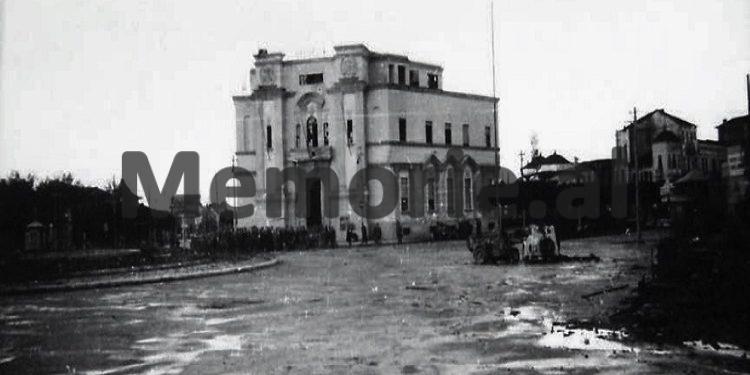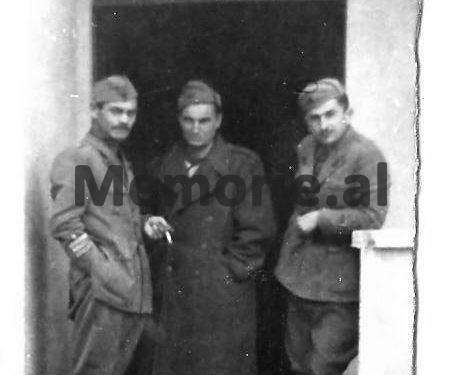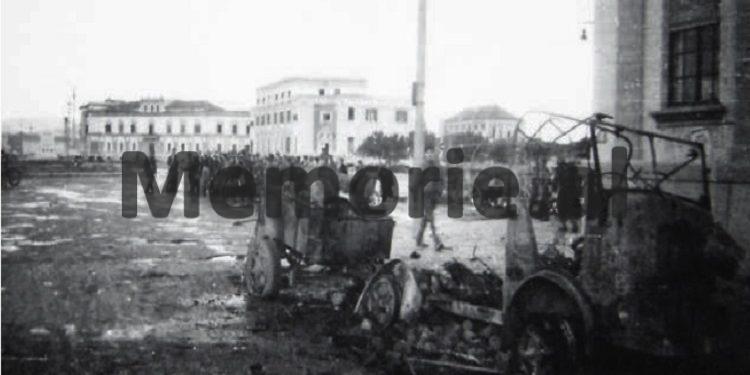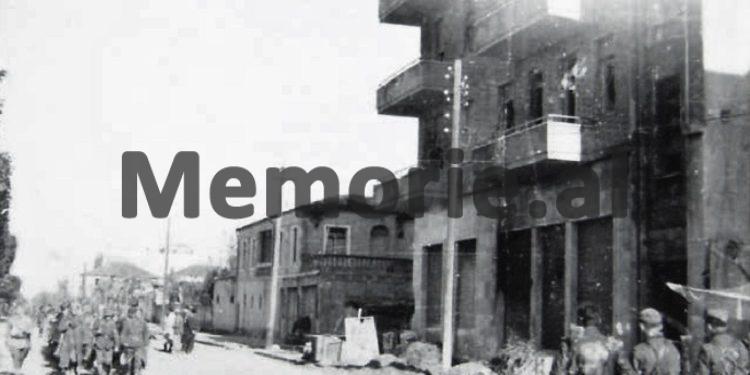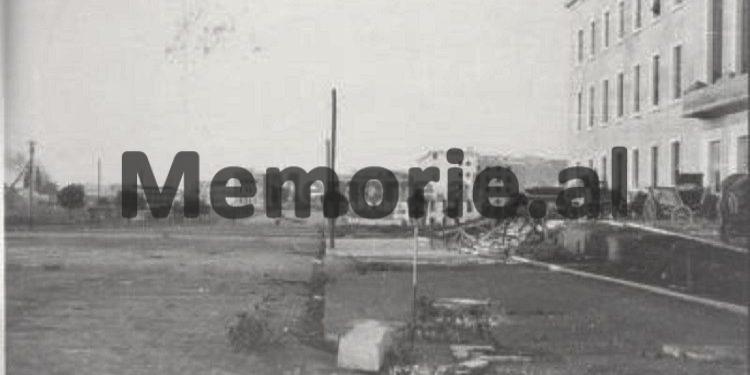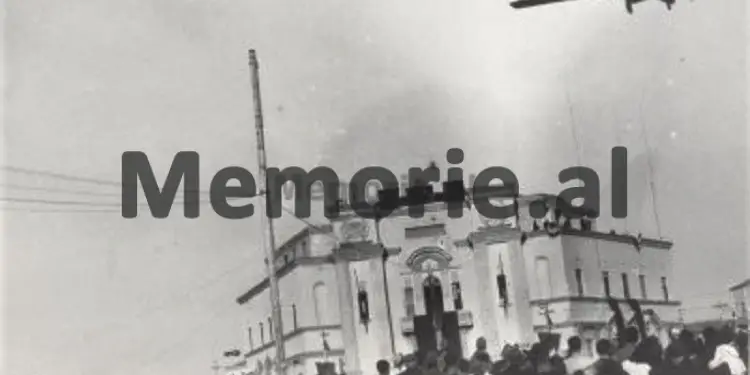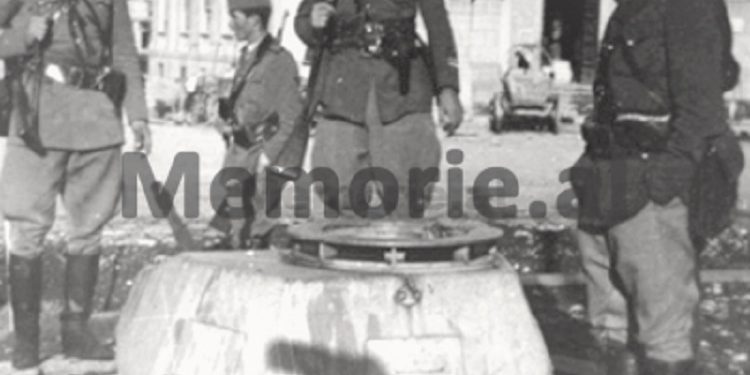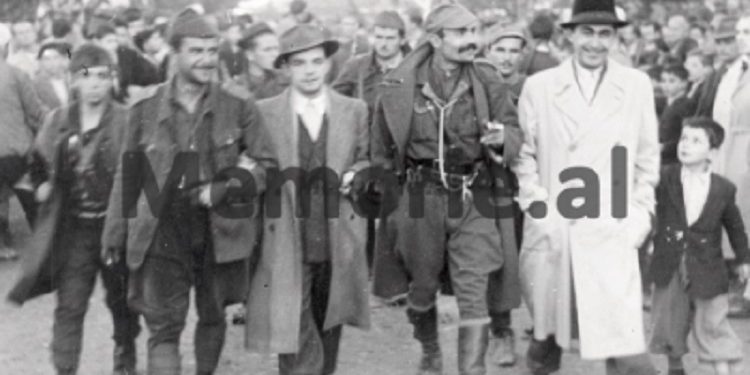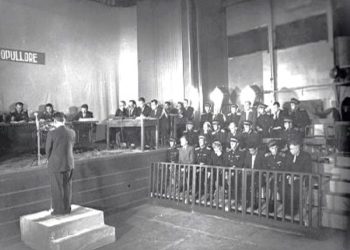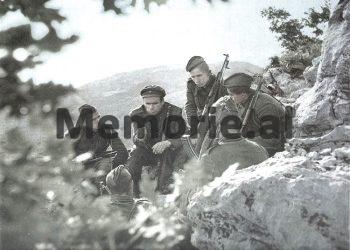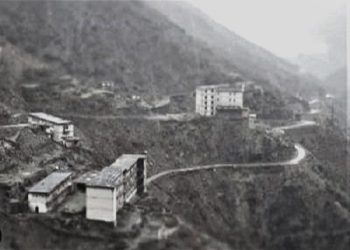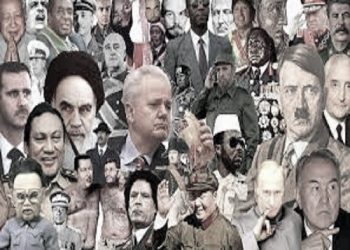From Uran Butka
Memorie.al / After the massacres caused by the civil war throughout Albania, it was the turn of the capital as well. A massacre by the communist forces had been prepared in detail, under the pretext of annihilating the reaction and cleansing the country. According to the strategy of the Albanian Communist Party and the special scenario for Tirana, the day of liberation should find Albania, and especially the capital, without those pro-Western nationalists and intellectuals, without the well-known figures of Albanian culture and education, without those patriotic officers, who were not joined the Front, the honest employees, without the owners, traders and businessmen who lived in the market economy of the Albanian state, without those patriots and democrats, who had fought and aspired for an independent, united and democratic Albania. One of the fiercest supporters and organizers of this genocide, Kristo Themelko, an agent of the Yugoslavs with the Slavic nickname “Shulja”, says:
“This terrorist road of ours was born as a line…! From this it follows that all those elements who are against us, but for which there are no facts, should be shot right now… Not only did you clean them up during the war, but you had to clean them up in such a way that they would not be understood by the people… They were also killed those who surrendered.”
Of course, this genocide was not sporadic, but organized and directed by the chief terrorist Enver Hoxha, who later tries to wash his hands like Pilate.
“When I talked with Enver, – Kristo Themelko claims, – he advised me that when we entered the city, we should clear the dangerous elements. Therefore, when I entered Tirana, I requested a list from the organization for these elements”. Gogo Nushi, the district secretary of the Communist Party of Tirana, affirms the massacres in his own words, in his reports to Enver Hoxha, where he writes: “We have seen this terrorist spirit in the last few days in Tirana. This shows our line. With the entry of our forces, 60 people were killed. We have the list. I think none of them deserved this punishment. We are sure we will have others. The number will have exceeded 100”!
So, we are dealing with genocide with political motives and national dimensions. In Tirana, they were killed without trial and without guilt, treacherously and in the middle of the night, in groups or one after the other, even on the thresholds of houses, on the corners of alleys, on the banks of the river, in Sharre, Priskë and Sauk, without giving any explanation , without leaving any trace, leaving even without a grave, well-known figures from all Albania, from Kosovo, Dibra e Madhe and Chameria, even foreign citizens, so that terror and fear could be felt everywhere and spread around -circles, from Tirana to all Albanian territories. Because with terror and blood, they would take and keep power, because only in this way, the most unparalleled and bloodiest dictatorship, in all the countries of the communist East, Enver Hoxha’s dictatorship, could be established and functioned.
The first political murder was that of the prominent Tirana cleric, Selim Brahja, on August 31, 1943, before the ink of the Mukje National Agreement was even dry. After its destruction by the Albanian Communist Party, under the pressure of the Yugoslav Communist Party, the civil war provoked by the Slavo-communists began. Selim Brahja is one of her victims. They killed him in front of the door of God’s house, at the threshold of the Mosque.
Seven members of the punishment unit of the Peza group, with red scarves on their heads, shot him several times and disappeared to escape the rifles of Selim Brahje’s house. This murder also marks the beginning of communist terror in Tirana. Yes, why did they kill this man, who had dedicated his life to God and Albania?!
He came from a patriotic family. His father, Ramazan Brahja, participant in the raising of the flag on November 26, 1912 in Tirana. Selim Brahja, an intellectual, trained in Theology in Istanbul, devoted himself to religion and Albanianism. He opens the first Albanian school in Sauk. During the Italian occupation, he was sentenced to prison by the fascists, since in his house, he hosted both nationalists and partisans, who were fighting for freedom. He participated in the Assembly of Mukje, together with Ismail Agë Petrela, Dr. Nroqin, and other Tirana nationalists.
That’s why people with a star and a red scarf on their heads killed him. On October 29, 1943, the penal unit of Peza barbarically massacred Besnik Çanon (22 years old) and Qeramudin Sulo (21 years old), two young nationalist intellectuals, participants in the Mukje Conference, who were going to the south of Albania to convey the message of this national agreement.
13 shot without trial by Mehmet Shehu…!
In October of this year, Mehmet Shehu, shot without trial in Priska, 13 gendarmes who surrendered in good faith to the First Assault Brigade, to fight with him against the Germans, among them: Preng Marku from Kačinara, Zef Ndoc Simoni from Fishta, Preng Lek Shkreli from Malësia e Shkodra, Pjetër Shkalleshi from Kthella and captain Ali Maksuti, from Margëlliçi i Çamërësia, former well-known florist of Tirana. Later, they also killed Professor-Doctor Lorenc Rasha, from Shkodra, the man of knowledge.
He completed high school and university in Austria with excellent results and a doctorate in linguistics. He earned three other scientific doctorates with exceptional work and skills in European universities, as well as mastering many Western and Eastern languages.
This well-known intellectual and nationalist were shot without trial on September 12, 1944 by the firing squad of the “Dajti” partisan battalion, by the Priska stream, in the place called Paraspur.
The murder of a cleric, two students, an intellectual and dozens of soldiers was the prologue of the communist terror in the outskirts of Tirana, which descended from there into the heart of the capital. The story of this tragedy opens on the night of October 28, 1944, when the communist forces who were illegal or who had penetrated those days in occupied Tirana, instead of hitting the German invaders, sneaked into Tirana houses at night, like hyenas, and arrested or shot, the Albanians who were marked on the death lists by their leaders. Thus, they did it at midnight at Ymer Dërhem’s house and arrested Akil Sakiq, Nazmi Uruçi and Fahri Dabulla. “They ask you for an explanation.” But they were shot that same night.
Akil Sakiqi, was from Dibra e Madhe. His native family, followed by the Serbian-Macedonian genocide, moved to Turkey, then settled in Tirana. Akili, after graduating from the Lyceum of Korça, completed the Military Academy in Rome, branch of the Financial Guard. He served devoutly in Durrës, Shkodër, etc., always in the background. On April 7, 1939, he fought with Myftar Jegen and many other officers of the National Army against the Italian aggression.
Even Nazmi Uruçi, from Dibra e Madhe, was from a patriotic family. Fahri Dabulla from Gjirokastra. Adili, Nazmiu and Fahriu, all three well-known career officers, ardent patriots, honest and untainted Albanians, had completed the Korça High School together with Enver Hoxha. Terrorist Hoxha put his high school friends on death lists. Unsatisfied with their deaths, he mentions them with pathological hatred and shows no sign of remorse even decades later, in his books, when he tries to falsify history.
“Just before the plenum, Sejfulla Malëshova comes to me, all “alarm”.
– It is becoming a lot of terror, – he tells me with all his anger.
– Terror? – I asked him in surprise. – Where?
– In Tirana, – he answers me. – Many repentant officers are being killed.
– In Tirana, the great struggle for the liberation of the capital continues, – I told him. – Who do you call terror? And which officers are you complaining about?! What hypocrisy! It is known that in the plenum of Berat (November 24-27, 1944), in front of the representative of the Yugoslav Communist Party, Velimir Stoinič, Enver Hoxha admitted very submissively:
“They are being killed in Tirana, with dozens of people and second-rate officers who, having full faith in justice and in our proclamation, surrender. Such work is not occasional, but is the whole tone given to the organizational work of the party and the army. Our comrades only think of exterminating every person who is not with us, who does not think like us, to exterminate even simple people of the people”.
The night of October 28 was designated by the Communist Party Circuit for Tirana as the night of mass murders of career soldiers. That night they were shot: Hamit Greblleshi, from an autochthonous family of Tirana, a teacher and later, after completing the Military Academy in Istanbul, an officer of the Gendarmerie of the Albanian state, until 1939, when he was released for health reasons. “Could a man be killed who had served as a rearguard officer for three months”? – asks Kujtimi, Hamit’s son. – “This question has followed us all our lives since the day our father was killed.”
The other son, Mustafai, the author of the famous novel “The Abyss of Love”, was imprisoned and suffered in the hell of communist prisons, but he maintained that he had the genes of his father, to whom he dedicated the elegy “in cell 79 of the Tirana prison” Tranquility”.
Hamit Greblleshi, was arrested together with other officers who lived on “Tabakë” Street, Hasan Dinen from Maqellara e Peshkopia, with a military academy completed in Italy, a patriot son of a patriot, Azis Blloshmin, from the well-known Blloshm family, from Bërzeshte , who had completed his military studies in Vienna, Faik Shkupin, an Albanian from Skopje, trained as a soldier in Italy and served in Albania, Mehmet Dadon and Boris Belevskin, a white Russian, an officer in the Albanian army, Aleks Mavraqi, Selmam Shtjefni, Bajram Cuka , and others whose graves are not even known.
Genocide for political motives continued with intensity in and around Tirana. On November 3, 1944, the communist forces shot three prominent Deliallis of Shijak without trial in Sharra of Tirana: Kapllan Deliallisi, deputy of Shijak in the Albanian Parliament and his brother, Jakup Deliallisi, former mayor of the municipality of Shënavlash and Luz. Along with them, Shefqet Deliallisi, the son of the well-known patriot Ymer Deliallisi – personal secretary of Ismail Qemali, a young officer, graduated from the Military Academy in Rome, but who welcomed the fascist invasion with indignation and left from office, because he was against the invaders, just as the Deliallis of Shijak have been for generations.
Along with these martyrs, Isuf Allamani, from the family of Allamani of Mati, was also shot. What had Isufi done that killed him? He had studied Agronomy at the University of Florence and had returned to Albania to help in the country’s economic renewal. He founded Xhafzotaj Farm, a modern agricultural capitalist economy, and was its director when he was arrested and shot without trial, although he had not interfered at all in political affairs.
And in Sharre, five other victims were shot without trial and jumped on each other in a stream: Captain Bajram Cuka, Selim Kelmendi, Ndue Pali, Minella Toçi and Selaudin Korça. Selim Kelmendi, from Vuthaj i Gucië, had fled the Serbian-Montenegro terror with a gun in his hand, along with his two brothers, Rustem and Ramë, members of Azem Galica’s gang, but he could not escape the terror of the Albanian Chetniks.
Selaudin Korça, the son of the great patriot, cleric, philosopher, publicist, poet and well-known anti-communist, Hafëz Ali Korça, who continued his higher studies in Italy, but who came to Albania to become a victim of communist terror. On November 10, Officer Subi Topulli from the prominent Topulle family of Gjirokastra fell prey to this terror, at Ura e Brari. The killers massacred him and destroyed every trace of him, saying that; had escaped from Albania.
Big families and intellectuals were hit
So we come to the night of November 12 in Tirana, which is also called “Night of Saint Bartholomew”. That night, the biggest massacre took place, a collective punishment and murder without trial, of 14 prominent figures of the nation and of Albanian culture. Ismail Agë Petrela is one of the major figures of Albania, who was shot at midnight on November 12.
Why did they put Ismail Petrela on the death lists? Because he was from a large family, he himself was an outstanding nationalist, a freedom fighter, a determined democrat, a wise man from Tirana, a well-known intellectual who knew several Western languages, a man of culture, especially music. .
The culminations of Ismail Agë Petrela’s patriotic activity are the active participation in the June Revolution, the Fier Movement, the Peza Conference, the Mukje Assembly and the fight against the Italian invaders, at the head of his company, which operated in Central Albania. . This is why the communists killed Ismail Agë Petrela! At the time of the shooting, he told the executioners: “Shoot, men die once”!
The terrorists, this time, chose to massacre the prominent Kokalari family, from Gjirokastra. Muntaz, Vesim and Syrja Kokalarin were shot on the night of November 12, in the hideouts of the “Bristol” hotel. Muntazi and Vesimi, pioneers of national education, founders of the “Albanian Messages” Publishing House, which published major works of our and foreign literature, first-class intellectuals, together with their brother, Hamit Kokalari, who wrote the book of famous: “Kosovo – the cradle of Albanianism” and sister Musina, the first Albanian writer, nationalist and outstanding democrat, whom the dictatorship then imprisoned and exiled until she died.
That same day, communist terrorists also shot Nebil Çika, the philosopher, publicist, great democrat. He has been the editor and chief editor of several Albanian free press bodies, such as: “Revista Pedagogjike”, “Reforma”, “Jeta”, “Arbëria”, “Miku i Populli”, “Minerva”, “Bota e Re” etc. ., and author of the well-known work: “The Albanian Mind”, which placed him in the chosen elite of the nation. Exactly, these elite were killed by communism.
He hit the big families, which had produced prominent people, to interrupt the tradition, to dry up the source, to wither and subjugate Albania. One of them is the Lleshi family from Tirana. All her men sacrificed themselves for a free Albania, united in its ethnic and democratic lands. Muharrem Lleshi, welcomed the Italian invasion with indignation, while his two sons, Sulejmani and Islami, nationalists, were interned by the Italians in Italy and Porto Romano, then they were fighters of the “Besnik Çano” nationalist battalion of the “National Front”, which also fought in Kosovo for its liberation. Sulejmani, founded the gymnasium of Gjakova and was its first director.
At midnight on November 12, armed terrorists entered the yard of the Lleshi house, where anti-fascist or illegal demonstrators were sheltering, and called the name of Muharrem Lleshi. As soon as he appeared at the door, a burst of machine gun fire left him dead and covered in blood.
The other well-known Tirana family that was hit was the Stermasi family, which produced well-known people, such as; Xhaferr Stermasin, flag bearer of Independence. The son, Reshati, born with Albanianism and knowledge, completed his higher studies at the Military Academy in Italy and serves devoutly in the Albanian National Army.
In April 1939, in protest against the Italian occupation, he resigned, because he did not want to serve the fascists. Participates in anti-Italian protests and demonstrations. As a pure nationalist, he participated as early as 1942 in the “National Front” Organization and in 1943; he was appointed commander of the “Balli” Youth of Tirana, which he led in the war against the Italian and German invaders. This is why they killed Reshat Stërmas!
Even Rifat Tërshana, from Dibra e Madhe, a recruitment officer who served with dedication in Korçë, Fier and Durrës, did not escape their “prey”. Meanwhile, he also helped the National Liberation Movement. But they didn’t count it when they shot him on the bloody night of November 12. Terror also massacred ordinary people, untroubled by politics. Lluka Jumari, from the city of Durrës, had completed technical school in Italy and had become a master in his profession. A man with private initiative, he opened a small workshop, which he expanded into the SAKT automotive company.
They shot him in the ruins of the “Bristol” hotel, because he was a man of business, of free initiative, of the market economy, a successful investor, a philanthropist, a man of the future. Likewise, Ali Panariti, from Korça, a well-known merchant in Tirana and Durrës, and then a road construction entrepreneur. The terrorists, led by the secretary of the communist cell, R. Dobrolishti, took Ali from the house and shot him without trial, on the banks of the Tirana River, where the children found him half buried.
The epilogue of this fundamentalist terror was the massacre of Jorgji Mema, by a patriotic family from the village of Shtërmen in Elbasan. He had completed the ‘Normal’ school, but his desire was to serve as a soldier for the Albanian state, then in the function of the mayor of the municipality of Baldushku and Mollas. Jorji and the entire tribe of Memaj, threw themselves into the fight for freedom against foreign invaders.
The communists arrested him in Tirana on November 16, 1944 and shot him immediately, in the alley of the “Kristoforidhi” school. The good citizens of Tirana buried the martyr Jorgji Mema in the yard of this school. This is how this act of communist terrorism that bled Tirana ended, to pave the way for state terrorism that bled Albania and the nation for half a century. Memorie.al




